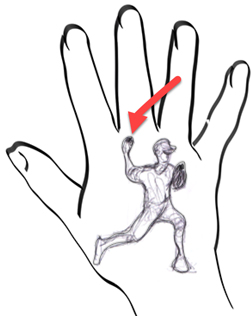Action Sketching: How to draw abstract hands
There are numerous, very generous tutorials on the web that teach how to draw anatomically correct hands, but unless you are creating formal portraits, often it is what you don’t see that shapes the perception of what is going on. Frequently, portions of hands and fingers are hidden, either behind something, like a sports ball, or they are just to small to be seen clearly.
To demonstrate how tiny hands can be in a drawing, I sketched a pitcher inside of a full-size trace of my own hand. You might think his right hand is about to throw a ball, but it is your imagination, not your eyesight that informs you. Although in my last blog I did show a detailed drawing of a hand holding a softball, even in that picture, your imagination informs you what that hand looks like behind the ball and not anything I expressly showed you.
 When sketching characters in action, abstract images become the key ingredients of suggested reality. Rather than worry about hand anatomy, make sure the general shapes you draw suggest what you want your viewers to see, then trust their imaginations to fill in the rest.
When sketching characters in action, abstract images become the key ingredients of suggested reality. Rather than worry about hand anatomy, make sure the general shapes you draw suggest what you want your viewers to see, then trust their imaginations to fill in the rest.
Jim Lee, a highly regarded comic-book artist, writer, editor, and publisher, produced the best tutorial on the subject of abstract hand shapes I’ve ever seen! Use the tips shared in the following video and you’ll never have trouble drawing active hand motions again.
In my next blog on action sketching, I’ll again turn to Jim Lee’s advice on how to show body motion without too much concern about anatomy. If you use a fully-jointed mannequin, as suggested in Action Sketching: A supplies list, you’ll get even more out of that lesson.
Links:
- Jim Lee, biographical information: DCComics.com
- List of Jim Lee’s tutorials on YouTube
- Jim Lee on Facebook: If you are not already on Facebook, if you are serious about action sketching, Jim Lee’s fan page is a good reason to join
Author:
This article was written by Karen Little as part of an ongoing series of blogs on Action Sketching. Published on Littleviews.com. January 22, 2020.
Reproduction of this article is free to non-commercial websites (or other media) with permission and attributes to Littleviews.com and the article’s author.
All material on Littleviews (with noted exceptions) is copyrighted on the date of publication.
Questions? Ask Karen Little at karen@littleviews.com.